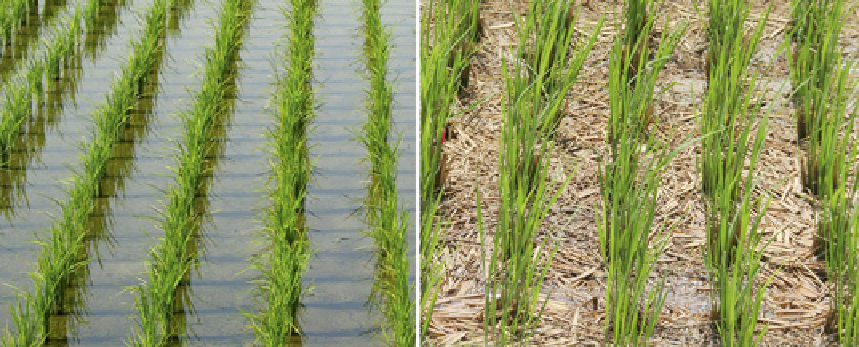Agriculture Reference
In-Depth Information
Fig. 13.8
A new mitigation technology for methane known as alternate wetting and drying
technology for methane known as alternate wet-
ting and drying (AWD) (IRRI
2009
) (Fig.
13.8
).
AWD is a water-saving and methane mitigation
technology that lowland (paddy) rice farmers can
use to reduce their water consumption in irrigated
fi elds. Rice fi elds using this technology are alter-
nately fl ooded and dried. The number of days of
drying the soil in AWD can vary according to the
type of soil and the cultivar from 1 day to more
than 10 days.
Starting from about 15 days after transplant-
ing, farmers using AWD stop irrigating until the
water table goes 15 cm below the ground level. A
20 cm hole is dug in the rice fi eld, and a perfo-
rated plastic pipe is installed to monitor the level
of the water table after each irrigation (Fig.
13.9
).
This practice is continued until fl owering starts.
At that time, it is necessary to keep 2-4 cm of
standing water from fl owering to dough stage.
This technology is very common in countries
such as China, India, and the Philippines (IRRI
2002
).
(i)
Advantages
• Large reductions in methane emissions are
possible compared to continuous fl ooding
(Table
13.6
).
• It will help the economic use of water dur-
ing rice cultivation.
• The drying phase of rhizosphere will help
root growth and its sustainability for water
transport to rice plants even under low soil
moisture conditions.
Fig. 13.9
Alternate wetting and drying (AWD) technol-
ogy for methane mitigation. The water table level has
been lowered to the stress stage (15 cm depth) so that it is
time to fl ood the fi eld again (IRRI
2009
)
• Farmers will be able to know the status of
water of their rice-growing fi elds and
would be able to balance irrigation with
achieving minimum methane emissions.
• The savings of irrigation water will have
impact on environment because of reduced
withdrawal of groundwater and a reduc-
tion in consumption of diesel for water
pumps.
• The protection of water levels of ground-
water may also reduce arsenic contamina-
tion in rice grain, and straw.
AWD technology can reduce the number of


Search WWH ::

Custom Search